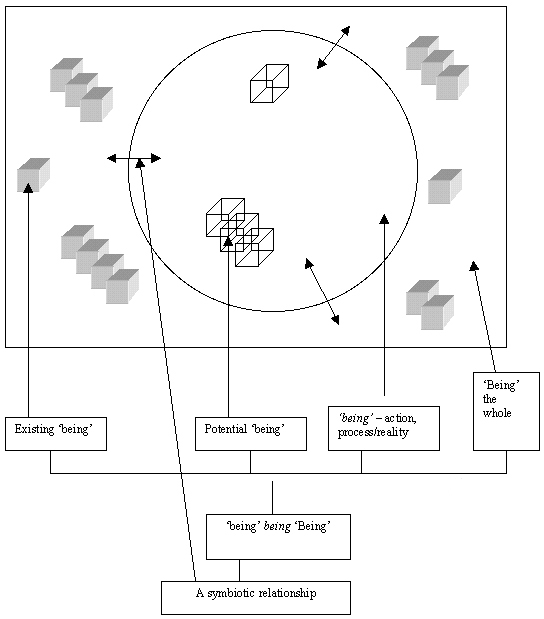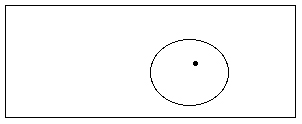Or simply ‘being’ being ‘Being’.
Resolving Kant’s four antinomies : (Antinomies: a pair of conflicting propositions for which equally cogent proofs can be given on either side.)
Antinomies: a pair of conflicting propositions for which equally cogent proofs can be given on either side.
Kant believed that antinomies were generated whenever human reason applied itself to any of the following four questions:
- Does the world have a beginning in time and a boundary in space, or is it without beginning and without bound?
- Are composite substances made up of simple substances, or do they contain parts within parts ad infinitum?
- Are there any actions that are free, in the sense of being caused by volitions that are themselves uncaused, or are all actions caused by causes that have their own causes and so on ad infinitum?
- Is there an absolutely necessary being to serve as ground of the rest of what exists, or are all beings contingent? (Kim, Jaegwon & Sosa, Ernest, A Companion To Metaphysics, Blackwell Publishers, p.258, 1995.)
Philosophers have addressed fragments of these four antinomies in one form or another since the emergence of philosophy. Granted the four antinomies may have been collated and summarized as a group of four by Kant but the issues they identify have been around well before Kant himself.
There are several means to approach the issue of these four antinomies.
- One can demonstrate one aspect of each statement being correct and the other aspect of each statement being incorrect
- One can demonstrate both aspects of each statement being incorrect
- One can demonstrate both aspects of each statement being correct
Means one: One can demonstrate that one aspect of each antinomy is correct while the other aspect of each antinomy is incorrect
This is the process philosophy, in particular metaphysicians, have been attempting to move for the last twenty-five hundred years with no success. The process of demonstrating that one part of the statement is correct and thus the other aspect of the statement is incorrect is the process, which has been unsuccessfully employed by metaphysicians since the time of Zeno. The result: Philosophers and in particular metaphysicians are no closer to bringing the four antinomies to a close than they were since the emergence of philosophy itself.
Means two: One can demonstrate both aspects of each antinomy is incorrect.
To proceed in the direction of ‘proving’ both aspects of each antinomy to be incorrect is to begin with the assumption that our existence is but a ‘figment of the imagination of something other than ourselves’. Such a scenario is not to be discarded lightly but for the intents and purposes of this tractate it is much too complex a scenario to attempt to prove or disprove at this time.
Means three: One can demonstrate both aspects of each antinomy is correct
Means three is a new approach to the resolutions of Kant’s four antinomies. This approach has never been considered before the time of Kant. Kant, using ‘means one’, believing he resolved the four antinomies but was never able to demonstrate his solution in a clear and concise fashion let alone demonstrate his solution in a manner so clear and concise it could be demonstrated to everyone including the general public.
Up to and through the time of Kant, the answer would have been: No, there is no metaphysical system, which accounts for all eight scenarios (two for each antinomy)
Through the work of the two giants, Aristotle and Kant, and the assistance of many philosophers working between and after, the answer now becomes: There is a metaphysical system, which accounts for all eight cogent proofs (two for each antinomy) in such a manner as to demonstrate that all eight cogent proofs are simultaneously correct and thus do not contradict one another
The new metaphysical model of ‘being’ being ‘Being’, symbiotic panentheism, not only accounts for all eight scenarios but incorporates all eight scenarios into its systematic model. In fact, the new metaphysical model, a non-Cartesian system powered by a Cartesian system located ‘within’ the non-Cartesian system, not only incorporates all eight scenarios within the dynamics of its system but elevates each of the eight scenarios to a level of equal prominence and significance one to the other.
Having said this, let’s no move on to demonstrating how it is the model does what it professes to do.
The four antinomies:
- Does the world have a beginning in time and a boundary in space, or is it without beginning and without bound?
- Are composite substances made up of simple substances, or do they contain parts within parts ad infinitum?
- Are there any actions that are free, in the sense of being caused by volitions that are themselves uncaused, or are all actions caused by causes that have their own causes and so on ad infinitum?
- Is there an absolutely necessary being to serve as ground of the rest of what exists, or are all beings contingent?
become eight positions of perceptual argument, cogent proofs:
- The world has a beginning in time and a boundary in space.
- The world has no beginning in time and no boundary in space.
- Composite substances are made up of simple substances.
- Composite substances contain parts within parts ad infinitum.
- There are actions that are free, in the sense of being caused by volitions that are themselves uncaused.
- There are actions that are caused by causes that have their own causes and so on ad infinitum.
- There is an absolutely necessary being which serves as the ground of the rest of what exists.
- The absolute necessary being is like all beings, contingent.
It is one thing to address the eight issues in words; it is another to address the eight issues graphically. If Kant is correct in believing a system is critical to the issue of metaphysics then theoretical metaphysicians should, if the system is ‘clearly understood’, be able to put the system into the form of a simplistic metaphysical model. The simplest form of model is one, which can be drawn as opposed to just discussed in a form of a Wittgenstein dialogue of ‘words’. Words are the only means of discussing a metaphysical system when the metaphysical system is still too confusing to philosophers for them to demonstrate the system in the more demonstrative form of graphics or models.
Kant believed his metaphysical system addressed the eight issues listed above. Kant, however, could not address the eight statements, let alone model his system in a fashion, which would directly incorporate the eight issues, as equals one to the other. As such, Kant had not yet fully fashioned his metaphysical system into the form of being a fully understood system, which could adequately explain how it is all eight cogent proofs are just that: cogent proofs.
The reason Kant had such a difficult time explaining let alone demonstrating how his system resolved the eight cogent proofs was because Kant himself did not have a complete grasp regarding just ‘how’ his system functioned.
Kant’s metaphysical system was caught up in the same parameters of limits, which confronted Zeno. Like Zeno, Kant found himself confined by Aristotle. This becomes clear if we reexamine page two of this tractate and examine where it is Kant moved metaphysical perceptions.
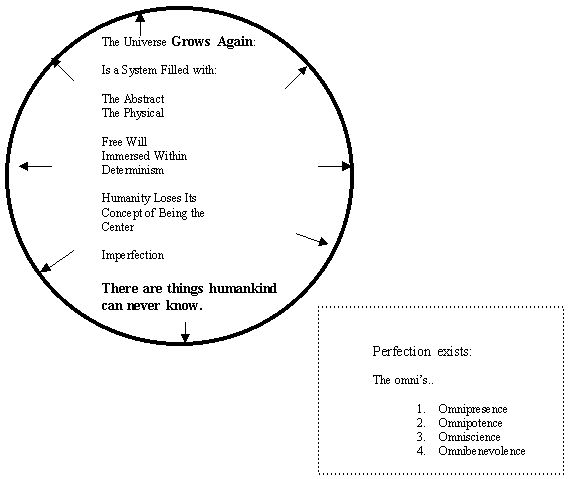
If we extract from the graphic the concepts superfluous to Kant’s most fundamental perception regarding ‘location’ of the phenomenal and noumenal found ‘within’ his metaphysical system, we obtain:
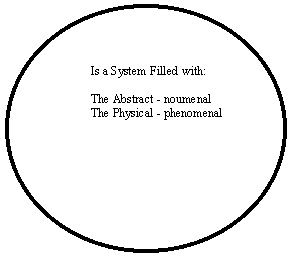
The process simply brings us back to Aristotle. This is not to say Kant had nothing new to add to the concept regarding the existence of ‘a’ metaphysical system. Quite the contrary. What is being said is that Kant, like Zeno (see Tractate 1: Zeno and Seamlessness), could not fully understand how his system worked. Like Zeno, Kant was subconsciously caught up in the perception of ‘a’ location of singularity versus ‘a’ location of multiplicity, a location consisting of two distinct locations existing through a process of ‘separation through inclusion’ versus ‘separation through exclusion’.
The examination regarding ‘separation through inclusion’ versus ‘separation through exclusion’ will take place in ‘Tractate 8: Russell. For now, however we must return to the task at hand, which is to examine the four antinomies with respect to the new metaphysical system of ‘being’ being ‘Being’.
Having stated the reason for Kant’s problem in understanding his own system, let’s examine a system, which would resolve Kant’s difficulties. This process will require several steps:
- Diagram the new system
- Demonstrate how it is all eight cogent proofs could be ‘a’ proof of what is without contradicting one another.
Logic is a subject in and of itself. As such we will leave the formality of logical proofs to others and instead examine the base foundation from which such logic should begin: The system itself. Thus when we speak of proofs we are referring to the most fundamental generalization of the proof versus the formal proof itself.
Part 1: The diagram:
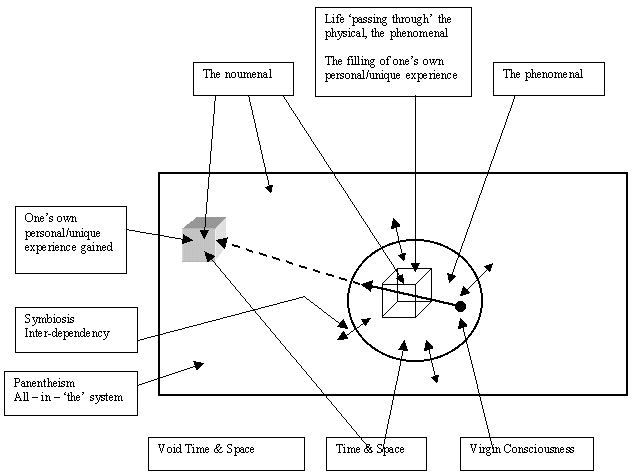
But isn’t this exactly what Kant’s system suggests. No, it isn’t. Kant’s system does not explain:
- The ‘growth’ component involved with the whole
- The interaction of the abstract and the physical – noumenal and the phenomenal as Kant would say
- The region ‘existing’ beyond the physical (meta-physics)
- The significance of individual ‘being’
- The significance of being
- The significance of ‘Being’
- The significance of ‘being being’
- The significance of ‘being’ being ‘Being’
- Relativistic 1st truth versus 1st truth
- What ‘powers’ the whole
- The dynamics of the whole interrelationship of the noumenal and the phenomenal
- Etc.
- Etc.
- And finally, yet most importantly to Kant: What ‘the’ ‘categorical imperative’ is.
Kant’s system would be diagramed as:
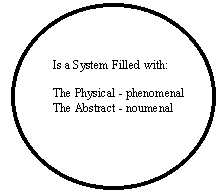
The model of the complete system demonstrates that the model is composed essentially of ‘one’ part.
The new metaphysical system being proposed, ‘being’ being ‘Being’, creates a model subdivided into ‘distinct’ sub-elements, which in essence gives us two parts: the phenomenal and the noumenal. This model can also be reduced to its most fundamental of elements. If we reduce this model to its fundamentals as we previously did to Kant’s perceptions, we obtain:
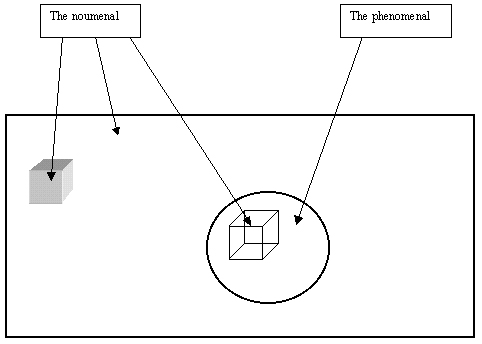
Having reduced ‘the’ system to its fundamentals, we can now proceed to Part 2.
Part 2: Demonstrating how it is all eight cogent proofs could be ‘a’ proof of what is without contradicting one another
It is perhaps best to take the eight statements and place them in groups of two, representing each antinomy.
The four antinomies:
- Does the world have a beginning in time and a boundary in space, or is it without beginning and without bound?
- Are composite substances made up of simple substances, or do they contain parts within parts ad infinitum?
- Are there any actions that are free, in the sense of being caused by volitions that are themselves uncaused, or are all actions caused by causes that have their own causes and so on ad infinitum?
- Is there an absolutely necessary being to serve as ground of the rest of what exists, or are all beings contingent?
Eight positions of perceptual argument placed into groups of two:
- The world has a beginning in time and a boundary in space.
- The world has no beginning in time and no boundary in space.
- Composite substances are made up of simple substances.
- Composite substances contain parts within parts ad infinitum.
- There are actions that are free, in the sense of being caused by volitions that are themselves uncaused.
- There are actions that are caused by causes that have their own causes and so on ad infinitum.
- There is an absolutely necessary being which serves as the ground of the rest of what exists.
- The absolute necessary being is like all beings, contingent.
Antinomy #1:
Does the world have a beginning in time and a boundary in space, or is it without beginning and without bound?
- The world has a beginning in time and a boundary in space.
- The world has no beginning in time and no boundary in space.
If we examine the new metaphysical model in terms of the two arguments, we obtain:
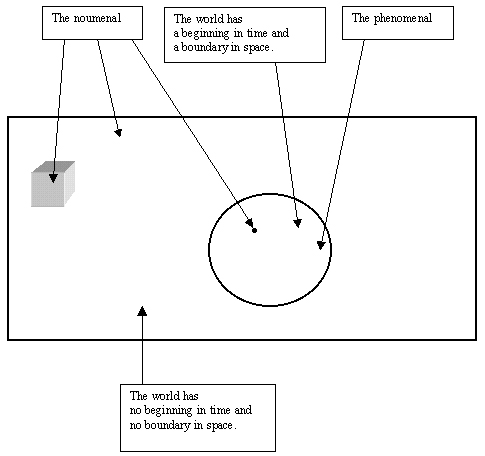
The term, ‘the world’, refers to the whole. In ontological, cosmological and metaphysical terms this has historically referred to the universe, to our reality, to what lies within the boundaries of the physical which Zeno left open yet closed (see Tractate 1: Zeno)
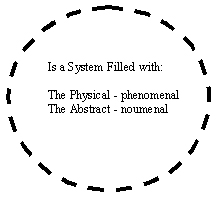
Aristotle tightly closed Zeno’s metaphysical system (see Tractate 2: Aristotle).
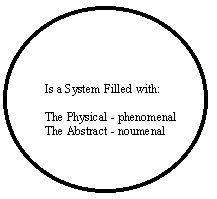
It is this system, which we reopen to obtain the system we suggested. If we then examine the concept of ‘world’ we see the two seemingly contradictory statements are only contradictory because the opposing sides are defining the word ‘world’ differently. In argument one: The word world refers to the physical universe, the phenomenal. In argument two: The word world refers to the whole of the system within which the physical world resides.
If we examine the two seemingly contradictory statements in light of the new metaphysical perception, we realize how it can be that the two arguments are not contradictory but rather each are correct and each reinforces the argument of the other.
Antinomy #1:
Does the world have a beginning in time and a boundary in space, or is it without beginning and without bound?
- The world has a beginning in time and a boundary in space.
- The world has no beginning in time and no boundary in space.
The answer is yes to both. The answer is both states of existence are needed to operate an active form of metaphysical system. The answer is that a non-Cartesian system powered by a Cartesian system located ‘within’ the non-Cartesian system, cannot exist without the two forms of existence, #1 and #2, themselves existing simultaneously independent one from the other yet simultaneously dependent one upon the other.
Antinomy #2:
Are composite substances made up of simple substances, or do they contain parts within parts ad infinitum?
3. Composite substances are made up of simple substances.
4. Composite substances contain parts within parts ad infinitum.
If we examine the new metaphysical model in terms of the two arguments, we obtain:
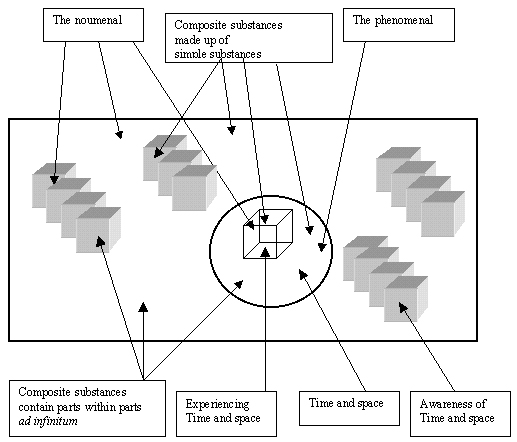
There are two issues to consider in terms of this antinomy. There is the physical and the abstract, the phenomenal and the noumenal.
The physical/the phenomenal:
The physical is found ‘within’ the universe. The universe is a region we call our reality. This in no way implies that the physical is found only ‘within’ our universe for there may well be multiple universes within such a metaphysical system.
The physical is found ‘within’ the universe. The universe is a region we call our reality. This in no way implies that the physical of which we are familiar, is the only set of physical laws to be found within universes for there may well be universes which are ‘ruled’ by entirely different ‘laws of nature’ than the ‘laws of nature’ we find to exist within ‘our’ universe.
The physical is found ‘within the universe. The universe is a region we call our reality. This in no way implies that ‘awareness’/’knowing’ regarding the physical remains ‘within’ the physical for within the metaphysical system suggested, awareness/knowing regarding the universe is a form of abstraction and thus permeates abstraction itself. The regions of abstraction permeated with awareness of the physical is found not only in the entities capable of ‘knowing’ found within the physical but found within entities of ‘knowing’ found ‘outside’ the physical as well as found perhaps within ‘the whole’ of abstraction itself.
Understanding these three statements leads to understanding the finiteness of the physical but what of the infiniteness, what of composite substances contained as parts within parts ad infinitum
If Kant is correct in his perception regarding the system of ‘critical philosophy’, than what is observed changes by the very fact that it is observed. Such a perception allows for an infinite creation of parts within parts ad infinitum. The reason being that as we observe smaller and smaller parts, the parts continually become divisible through the active state of physical existence as opposes the Aristotelian passive state of physical existence.
Within the metaphysical system of ‘being’ being ‘Being’ infinite sub-division occurs not only in terms of the microscopic but in terms of macroscopic observations. The reason the principle applies to the macroscopic as well as the microscopic is that within such a system, the universe becomes ‘a’ part of the whole and as such is subject to the same infinite active process of division as the microscopic is to our observation for the universe simply becomes ‘a’ ‘part’ of the whole just as any object ‘within’ the universe becomes ‘a’ ‘part’ of the whole universe.
The abstract/The noumenal:
What of the noumenal/the abstract? From the model of the metaphysical system proposed, it becomes evident that the addition of entities of knowing, sub-units of the whole, is a continual process only terminated with the termination of time itself which is found in only two locations: within the entity of knowing known as awareness and within the universe itself which imparts the concepts of time and space through experiencing into the entity of knowing.
Such a means of establishing original knowing is not necessarily the only means of the whole establishing knowing but rather is simply ‘a’ means of establishing knowing which is available to the whole provided by our peculiar form of universe which itself incorporates the concept of time. Within such a metaphysical system, it is conceivable that other universes with universal fabrics other than that incorporating the concept of time may well exist as sources of new and unique forms of knowing.
As such:
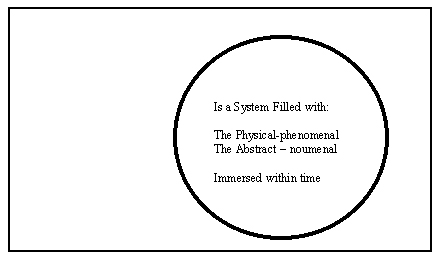
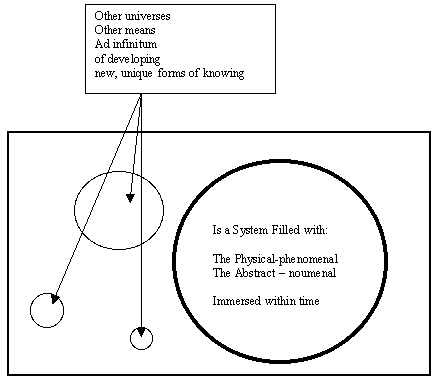
Thus if we examine the two seemingly contradictory statements in light of the new metaphysical perception, we realize how it can be that the two arguments are not contradictory but rather each are correct and each reinforces the argument of the other.
Are composite substances made up of simple substances, or do they contain parts within parts ad infinitum?
3. Composite substances made up of simple substances.
v
4. Composite substances contain parts within parts ad infinitum.
The answer is yes to both. The answer is both states of existence are needed to operate an active form of metaphysical system. The answer is that a non-Cartesian system powered by a Cartesian system located ‘within’ the non-Cartesian system cannot exist without the two forms of existence, #3 and #4, themselves existing simultaneously independent one from the other yet simultaneously dependent one upon the other.
Antinomy #3:
Are there any actions that are free, in the sense of being caused by volitions that are themselves uncaused, or are all actions caused by causes that have their own causes and so on ad infinitum?
1. There are actions that are free, in the sense of being caused by volitions that are themselves uncaused.
v
2. There are actions that are caused by causes that have their own causes and so on ad infinitum.
If we examine the new metaphysical model in terms of the two arguments, we obtain:
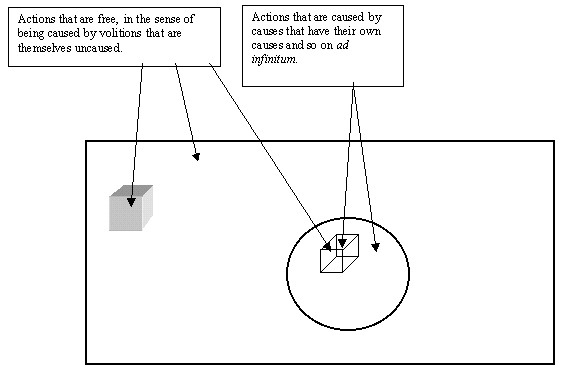
If we examine the two seemingly contradictory statements in light of the new metaphysical perception, we realize how it can be that the two arguments are not contradictory but rather each are correct and each reinforces the argument of the other.
The details of such an argument are complex and require a complete tractate to address. Tractate 3: Boethius and Free Will addressed this issue in detail. As such, rather than reiterate the concepts of such an argument, the reader will be referred back to Tractate 3.
However it must be emphasized here, regarding the question:
Are there any actions that are free, in the sense of being caused by volitions that are themselves uncaused, or are all actions caused by causes that have their own causes and so on ad infinitum?
1. There are actions that are free, in the sense of being caused by volitions that are themselves uncaused.
v
2. There are actions that are caused by causes that have their own causes and so on ad infinitum.
The answer is yes to both. The answer is both states of existence are needed to operate an active form of metaphysical system. The answer is that a non-Cartesian system powered by a Cartesian system located ‘within’ the non-Cartesian system cannot exist without the two forms of existence, #5 and #6, themselves existing simultaneously independent one from the other yet simultaneously dependent one upon the other.
Antimony #4:
Is there an absolutely necessary being to serve as ground of the rest of what exists, or are all beings contingent?
3. There is an absolutely necessary being which serves as the ground of the rest of what exists.
v
4. The absolute necessary being is like all beings, contingent.
If we examine the new metaphysical model in terms of the two arguments, we obtain:
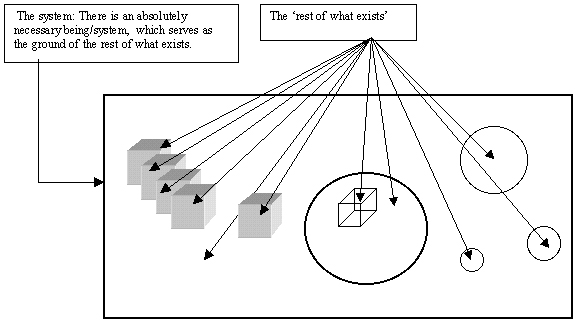
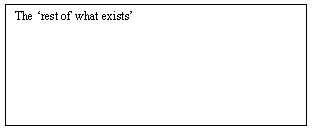
Within the metaphysical system of ‘being’ being ‘Being’, symbiotic panentheism implies the system is the summation of all the parts of the system. Therefore if all the parts but one are removed than the one remaining part is the ‘rest of what exists’.
The metaphysical system also suggests that removing any combination of multiple parts results in the same scenario in that what remains is the ‘rest of what exists’
In addition the metaphysical system suggest therefore that the sum of all the parts is greater than the sum of its parts for the sum of the parts is an entity in and of itself.
The emergence of paradoxes generated from a metaphysical system of the whole being our universe is nothing short of an indication that we are continually learning. If the whole is an active entity then ‘newness’ is constantly being generated as opposed to simply existing just beyond our reach awaiting our discovery.
If newness were simply existing just beyond our reach awaiting our discovery, then given enough time it is conceivable we could eventually know everything there is to know. This is what is referred to as a passive form of existence.
On the other hand:
If newness is constantly being generated then given enough time it is inconceivable we could eventually know everything there is to know for the more we observe and learn the more that is created. This is what is referred to as an active form of existence.
Thus if we examine the two seemingly contradictory statements in light of the new metaphysical perception, we realize how it can be that the two arguments are not contradictory but rather each are correct and each reinforces the argument of the other.
Is there an absolutely necessary being to serve as ground of the rest of what exists, or are all beings contingent?
5. There is an absolutely necessary being which serves as the ground of the rest of what exists.
v
6. The absolute necessary being is like all beings, contingent.
The answer is yes to both. The answer is both states of existence are needed to operate an active form of metaphysical system. The answer is that a non-Cartesian system powered by a Cartesian system located ‘within’ the non-Cartesian system cannot exist without the two forms of existence, #9 and #10, themselves existing simultaneously independent one from the other yet simultaneously dependent one upon the other.
The suggestion that we have resolved Kant’s four antinomies through the development of a new metaphysical perception leads us to examining a possible resolution regarding Kant’s ‘categorical imperatives’.
Could Kant accept such a metaphysical system as ‘being’ being ‘Being’? The system resolves Kant’s four antimonies. But what of Kant’s concept of the requirements he placed upon the concept of a system?
There were two fundamentals Kant felt should be accomplished with a metaphysical system that approached a significant advancement of metaphysical systems themselves:
- A categorical imperative should emerge naturally and obviously from such a system.
- The system should explain Kant’s belief:
‘According to Leibniz the physical world of cause and effect proved the inner harmony of the world’s moral purpose. Reading Leibniz led Kant to see humanity as not only participating in nature, but over and above this participating in the ultimate purpose of the universe.’ (Paul Strathern, Wittgenstein in 90 Minutes, St. Edmunsbury Press, 1996, p. 18.)
Due to the unique concept of a categorical imperative to Kant’s work and due to the fact Kant was unable to find his categorical imperative, which should have emerged from his system, we will provide the concept of categorical imperative its own unique section within this tractate.
As to the second fundamental:
The system of ‘being’ being ‘Being’ fully addresses the issue of the ultimate purpose of the universe and humanity’s participation in nature.
The understanding of such functions found within the metaphysical system of ‘being’ being ‘Being’ can better be understood if we use the generic name for the system, symbiotic panentheism. This metaphysical system assigns the task of producing ‘new knowledge’, new knowing, to the universe. In such a system it is entities of knowing emerging from virgin consciousness and experiencing isolated from the whole and through the application of free will that new untainted knowing emerges. and grows the whole. Thus the universe becomes the location and the virgin entity becomes the means for such growth. The universe gains purpose, a function, and humanity as well as all forms of knowing ‘knowing’, move through time and space, the universe composed of matter and energy, in order to develop and expand upon their virgin consciousness, in order to expand omniscience itself. Thus symbioses:
The parts to the whole and the whole to the parts become active action itself in terms of the whole and its sub elements of emerging knowing. Thus panentheism: The universe becomes an element of the whole.
The prioritized natural emergence of the first two categorical imperatives
Kant’s categorical imperative’ calls for a consensus regarding ethics, ‘acceptable’ behavior
With the concept of ‘being’ being ‘Being’ what does/do the ‘categorical imperative’ or ‘categorical imperative/s’ become?
The principles regarding the ‘categorical imperatives’ of the metaphysical system of ‘being’ being ‘Being’ are:
- Every journey of awareness of ‘abstractual knowing’ has the right to journey unimpeded by the desires of others
- We have an obligation to prevent other’s from interfering with the creative journey’s of awareness of ‘abstractual knowing’
Are these statements simply reiterations of the various forms of what the West calls the ‘Golden Rule’?
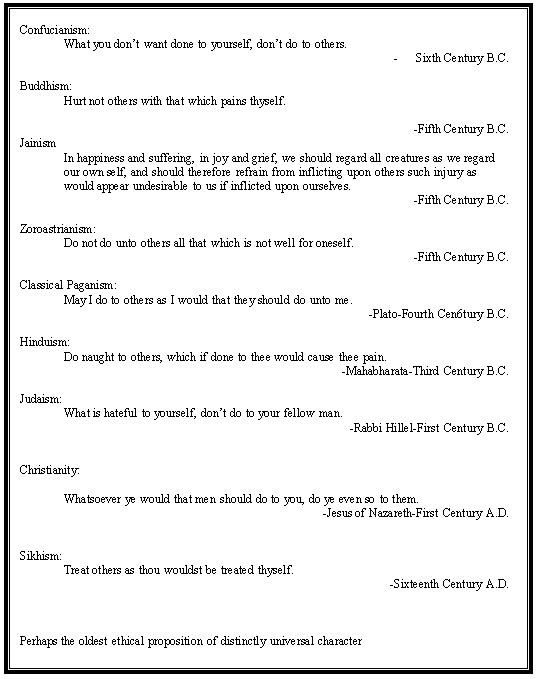
Such an example of slightly altering ‘a universal statement’ is exactly what Kant had in mind when referring to a ‘categorical imperative’, however this is not ‘the’ ‘Categorical Imperative Kant was implying should be established as ‘the’ universal statement. As exemplary as this universal imperative may have been and may be today, it is fraught with hidden charades.
A charade applied as a ‘Categorical Imperative’ is no categorical imperative at all but only ‘appears’ to be a categorical imperative and is accepted as a categorical imperative because there is no better alternative to replace it.
The various statements of the ‘Golden Rule’ would imply a person who enjoyed being ‘hurt’ should perform hurtful acts upon another because they themselves enjoy being hurt and enjoy experiencing pain. i.e. the masochist
The various statements of the ‘Golden Rule’ would imply a culture embracing the metaphysical system of ‘survival of the fittest’, would be justified in subjugating the weak just as they would ‘wish’ to be subjugated if they should ever grow ‘soft’ and fall victim to what they would perceive as the unforgivable sin of ‘idleness’. i.e. The Zulus
The various statements of the ‘Golden Rule’ would imply a religion, not only ‘should’ but had ‘the moral obligation to’ convert non-believers should ‘their God require it’ in order to ‘save’ the soul itself from the eternal flames of hell. i.e. Christianity, Islam, etc.
The various statements of the ‘Golden Rule’ would imply a race was obligated to excise what they perceived to be ‘weak’ gene in the attempt to hone their own race into a being ‘perfection’ itself. i.e. Nazi Germany
What then can be said of history and our potential encounter with other intelligences throughout the realm of the universe/physical reality? History itself is littered with messages vividly illustrating what a lack of a ‘complete’ metaphysical system suggests will occur again and again in our future as we further explore our own planet and as we begin our travels throughout our solar system, our galaxy, and the far reaches of our universe.




